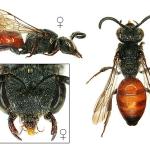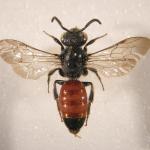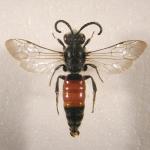Southern England, south Wales and the Channel Islands (Guernsey: Richards, 1979). There are no records from Ireland. This is a very rare bee with few recent records, these originating from Swanage, Dorset (1970); Kimmeridge, Dorset (1971); Branscombe, Devon (1978); Trelerw, Pembrokeshire (1994); Salisbury Plain, Wiltshire (1995 to date); Brackley, Northamptonshire (1997); Colchester, Great and Little Wakering, Essex (1998); Dorking, Surrey (1998), Goring, Oxon. (2000 to date). Found throughout much of central and southern Europe, the range extending east to the former south-east U.S.S.R. and Asia Minor. The species is also known from North Africa (Morocco).
Given as Rare (RDB3) in Shirt (1987), but listed as Vulnerable (RDB2) by Falk (1991).
Mainly chalk grassland and coastal landslips.
Univoltine, May to the end of June. This species and Sphecodes rubicundus are the only two representatives of the genus which, in Britain, have males which fly in the spring, rather than from mid- to late summer.
A cleptoparasite of Lasioglossum xanthopus (Perkins, 1923, 1924; Hallett, 1928). Morice (1901) considered that Andrena flavipes may be an additional host at Swanage, Dorset, but this seems unlikely and requires confirmation. At a site on Salisbury Plain, Wiltshire, the males have been observed flying in very large numbers about scattered hawthorn bushes, whereas the females were much scarcer and flew close to the ground (G R Else, pers. obs.). A pair has been seen there mating in a buttercup flower (S P M Roberts, pers. comm.).
Buttercup (Ranunculus species), spurge (Euphorbia species), Hogweed (Heracleum sphondylium), and Wild Carrot (Daucus carota).
No information available.
Profile written:
Proofed: January 2012




